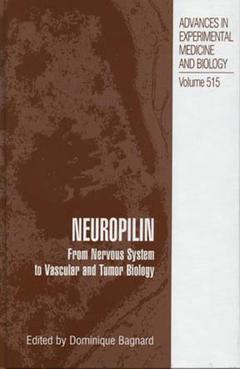Description
Neuropilin, 2002
From Nervous System to Vascular and Tumor Biology
Advances in Experimental Medicine and Biology Series, Vol. 515
Coordinator: Bagnard Dominique
Language: English
Neuropilin
Publication date: 10-2012
142 p. · 15.5x23.5 cm · Paperback
Publication date: 10-2012
142 p. · 15.5x23.5 cm · Paperback
Neuropilin: from nervous system to vascular and tumor biology
Publication date: 01-2003
140 p. · Paperback
Publication date: 01-2003
140 p. · Paperback
Description
/li>Contents
/li>
Cell adhesion is one of the most important properties controlling embryonic development. Extremely precise cell-cell contacts are established according to the nature of adhesion molecules that are expressed on the cell surface. The identifica tion of several families of adhesion molecules, well conserved throughout evolu tion, has been the basis of a considerable amount of work over the past 20 years that contributed to establish functions of cell adhesion in almost all organs. Nowadays, cell adhesion molecules are not just considered as cellular glue but are thought to play critical roles in cell signaling. Their ability to influence cell proliferation, mi gration, or differentiation depends on both cell surface adhesion properties and acti vation of intracellular pathways. The next challenge will be to understand how these molecules interact with each other to ensure specific functions in the morphogen esis of very sophisticated systems. Indeed, by exploring the cellular and molecular mechanisms of nervous system development, the group of H. Fujisawa in Japan identified in 1987 an adhesion molecule, neuropilin, highly expressed in the neuro pile of amphibian optic tectum. Ten years later, two groups discovered that neuropilin is a receptor for guidance signals of the semaphorin family. Axon guidance is a critical step during brain development and the mechanisms ensuring growth cone navigation are beginning to be well understood. The semaphorins are bifunctional signals defining permissive or inhibitory pathways sensed by the growth cone.
1. From the Discovery of Neuropilin to the Determination of Its Adhesion Sites.- Summary.- Identification of Monoclonal Antibodies that RecognizeXenopusNRP and Plex.- Molecular Cloning and Structure of NRP.- Expression of NRP in the Nervous System.- Cell Adhesion Properties of NRP1.- Conclusion.- 2. Neuropilins as Semaphorin Receptors: In Vivo Functions in Neuronal Cell Migration and Axon Guidance.- Summary.- Identification and Characterization of Neuropilins as Semaphorin Receptors.- In vivo Functions of Neuropilins in Nervous System Wiring During Development.- Conclusion.- 3. The Role of Neuropilin in Vascular and Tumor Biology.- Summary.- Neuropilin Expression in Endothelial Cells.- Regulation of Neuropilin Expression in Blood Vessels.- Neuropilin and Angiogenesis.- Tumor Cell Neuropilin.- Vascular Injury.- Perspectives and Future Directions.- 4. Neuropilin-1 In the Immune System.- Summary.- Neuropilin-1 is Expressed by Dendritic Cells and Resting T cells.- T Cell-Dendritic Cell Interaction Induces Neuropilin-1 Polarization in T Cells.- Neuropilin-1 Promotes Cell-Cell Interactions.- Neuropilin-1 Mediates the Dendritic Cells-Induced Proliferation of Resting T Cells.- Discussion.- 5. Structural and Functional Relation of Neuropilins.- Summary.- Primary Structure and Genomic Structure of Neuropilin.- Binding Properties of NRP Domains.- Neuropilin-1 Interacting Protein Binds to the Carboxyl Terminus of NRP1.- Additional Receptor Required for Signal Transduction.- Concluding Remarks.- 6. The Function of Neuropilin/Plexin Complexes.- Summary.- Neuropilins Form the Ligand-Binding Subunit of the Sema3A Receptors.- Plexins Act as the Signal-Transducing Subunit of Semaphorin Receptors.- Plexins are Essential Components of the Sema3A Receptor.- The Role of GTPases for Signal Transduction by Plexins.- Open Questions.- 7. The Interaction of Neuropilin-1 and Neuropilin-2 with Tyrosine-Kinase Receptors for VEGF.- Summary.- The Mechanism by Which NRPI Affects VEGF Induced Signaling by the VEGFR2 Receptor.- The Interaction of Neuropilins with VEGFRI.- Conclusions.- 8. The Function of Neuropilin/Ll Complex.- Summary.- L1 and NRP1 Associate Through Their Extracellular Domains.- L1/NRP1 Complex Formation Regulates Axonal Responsiveness to a Secreted Semaphorin.- L1/NRP1 Complex Specifies Growth Cone Responses to Sema3A.- Soluble L1 Modulates Axonal Responsiveness to Sema3A.- Other Putative Functions Served by L1/NRP1 Complex Formation.- Pivotal Molecules in Axon Guidance.- 9. Neuropilin and Its Ligands in Normal Lung and Cancer.- Summary.- Neuropilin and Semaphorin in Normal Mice Lung Development.- Neuropilins and Its Ligands in Human Lung Tumor.- 10. Neuropilin and Class 3 Semaphorins in Nervous System Regeneration.- Summary.- General Features of CNS Regeneration.- Semaphorin and Neuropilin in the Intact and Injured Olfactory System.- Neuropilin Ligands are Expressed by the Fibroblast Component of Neural CNS Scars.- Neuropilins are Expressed at the CNS Lesion Site.- Neuropilin/Semaphorin Regulation in Rat Models for Status Epilepticus.- General Aspects of PNS Regeneration.- Neuropilin/Semaphorin Regulation in the Injured PNS.- Conclusions.
© 2024 LAVOISIER S.A.S.





